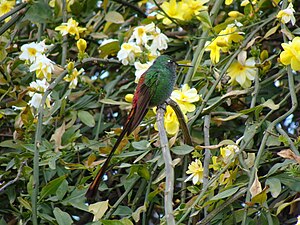Goldtail sylph
| Goldtail sylph | ||||||||||
|---|---|---|---|---|---|---|---|---|---|---|

Goldtail sylph ♂ |
||||||||||
| Systematics | ||||||||||
|
||||||||||
| Scientific name of the genus | ||||||||||
| Sappho | ||||||||||
| Reichenbach , 1849 | ||||||||||
| Scientific name of the species | ||||||||||
| Sappho sparganurus | ||||||||||
| ( Shaw , 1812) |
The golden tail sylph ( Sappho sparganurus ) or drag sylph is a sailing bird in the hummingbird family (Trochilidae). It occurs in the South American countries Bolivia and Argentina . The IUCN classifies the population as Least Concern .
features
The golden tail sylph reaches a body length of about 12 to 19 cm, depending on the length of the tail, with the slightly recovered beak being about 17 mm. The forked tail, consisting of rather thick flags with straight blunt ends, varies in length between 5 cm in young animals and 10 cm in adult males. Adult males are bronze green with a V-shaped emerald green throat. Large parts of the back and the ridge are purple. The tail is orange-red golden, whereby the golden looks green in the light and has velvety black spots on the ends. The blackish underside has a slight gold shimmer. The females have a pale yellow-brown underside with fine green spots. The significantly shorter tail has black spots with a white side border.
Young animals are similar to the females but have a bronze-green back with an only slightly copper-colored rump. The white of the outer control feathers easily penetrates into the inner vane.
distribution
The species occurs in the high plateaus, mountain forests of the Andes of Bolivia, Chile and western Argentina. There she inhabits the low vegetation. They are found at altitudes between 2000 and 4000 meters. They prefer dry mountain slopes with scattered trees and bushes and vegetation covered with herbs. In ravines they can also be found in thick scrub or semi-humid deciduous forests.
Way of life
This species feeds mainly on the nectar of the bush parasite ( Psitacnthus cuneifolus ), which it gathers while hovering . In addition, these birds take sunbaths more often to meet their high energy requirements. The males occupy a territory and vigorously defend it against male rivals. During the mating season, the birds flap their long tails up and down very quickly.
To its preferred plants which serve they belong Castilleja , sage ( Salvia ), and flowers with long cups, such as tobacco ( Nicotiana ), to the belt flower plants belonging Tripodanthus and the broomrape plants belonging Lamourouxia .
Brood
The nest, which is attached to a tree, rock wall, etc. Ä. Is made from plant parts, mosses. They are known to lay their eggs in Bolivia from April to June. In Argentina, in the province of Cordoba , breeding nests of the golden-tailed sylph were discovered in November.
Vocalizations
When they eat, they often utter a melodious tjrrt . When they sit on raised branches, their call sounds like sharp tsha and zack sounds, which they repeat monotonously at second intervals.
Subspecies
There are currently two subspecies:
- Sappho sparganurus sparganurus ( Shaw , 1851) - The nominate form occurs in northern and central Bolivia.
- Sappho sparganurus sapho ( Lesson ), 1828 - The subspecies is distributed from southern Bolivia through the northern and western parts of Argentina to the east of central Chile. An occurrence in Chile at the pass of Portillo de las Yeguas , as found in some authors, is doubted. The subspecies differ from the nominate form by the lilac-pink golden tail.
Etymology and history of research
The golden -tailed sylph was first described in 1812 by George Shaw under the scientific name Trochilus sparganurus and the common English name Bar-tailed Humming-bird . The type specimen came from the museum of William Bullock . He erroneously named Peru as the distribution area, a country in which the golden-tailed sylph does not occur.
The term " Sappho " goes back to a Greek poet. The specific epithet »sparganurus« is made up of the Greek words »Sparganō, sparganon σπαργανόω « for »wrap, tie, ribbon« and »ourá ουρά « for »tail«. The word "saphiro" has its origin in the Latin word "saphirus" for " sapphire ".
literature
- Jon Fjeldså , Niels Krabbe : Birds of the High Andes: A Manual to the Birds of the Temperate Zone of the Andes and Patagonia, South America . Apollo Books, Stenstrup 1990, ISBN 87-88757-16-1 .
- George Shaw: General Zoology, or systematic natural history . With plates from the first authorities and most select specimens, engraved principally by Mrs. Griffith. tape 8 , no. 1 . Thomas Davison, London 1812 ( online [accessed December 13, 2013]).
- René Primevère Lesson : Manuel d'ornithologie, ou Description des genres et des principales espèces d'oiseaux . tape 2 . Roret, Paris 1828 ( online [accessed December 13, 2013]).
- James A. Jobling: Helm Dictionary of Scientific Bird Names . Christopher Helm, London 2010, ISBN 978-1-4081-2501-4 .
- Javier González Zapata: Sobre la presencia en Chile de Sappho sparganura sappho (Lesson) (Aves: Trochilidae) . In: Boletín Ornitológico . tape 9 , no. 1/2 , 1977, pp. 10–11 ( online [accessed December 21, 2013]).
Web links
- Sappho sparganurus inthe IUCN 2013 Red List of Threatened Species . Listed by: BirdLife International, 2012. Retrieved December 13, 2013.
- BirdLife International: Species Factsheet - Red-tailed Comet ( Sappho sparganurus ) . Retrieved December 13, 2013.
- Videos, photos and sound recordings of Red-tailed Comet (Sappho sparganura) in the Internet Bird Collection
- Goldentail sylph ( Sappho sparganurus ) at Avibase; Retrieved December 13, 2013.
- Sappho sparganura in the Integrated Taxonomic Information System (ITIS). Retrieved December 13, 2013.
- xeno-canto: Sound recordings - Red-tailed Comet ( Sappho sparganura )

